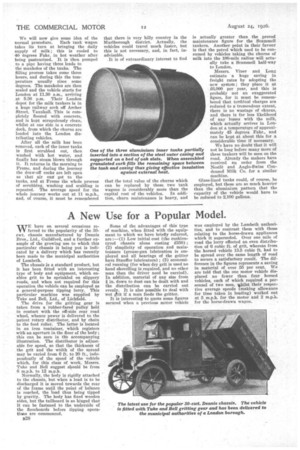A New Use for a Popular Model.
Page 46

If you've noticed an error in this article please click here to report it so we can fix it.
WE have on several occasions referred to the popularity of the 30cwt. chassis manufactured by Dennis Bros., Ltd., Guildford, and a further example of the growing use to which this particular chassis is being put is indicated by a delivery which has recently been made to the municipal authorities of Lambeth.
The chassis is a standard product, but it has been fitted with an interesting type of body and equipment, which enables grit to be sprinkled on slippery roads, and when not required for this operation the vehicle can be employed as a general-purpose tipping lorry. This particular machine was supplied by Tuke and Bell, Ltd., of Lichfield.
The drive for the gritting gear is taken from a rubber-faced pulley held in contact with the off-side rear road wheel, whence power is delivered to the patent rotary distributor, and by chain to the feed roller. The latter is located in an iron container, which registers with an aperture in the floor of the body ; this can be seen in tlfe accompanying illustration. The distributor is adjustable for speed, so that the thickness of the grit and the width of the spread may be varied from 6 ft. to 20 ft., independently of the speed of the vehicle which, for this class of work, Messrs. Tuke and Bell suggest should be from 6 m.p.h. to 12 m.p.h.
Normally, the body is rigidly attached to the chassis, but when a load is to be discharged it is moved towards the rear of the frame until the point of balance is reached, the load thus being tipped by gravity. The body has fixed wooden sides, but the tailboard is so hinged that it can be fastened to the underside of the floorboards before tipping operations are commenced.
B28 Some of the advantages of this type of machine, when fitted with the equipment to which we have briefly referred, are :—(1) Low initial cost (the cushiontyred chassis alone costing £350) ; (2) simplicity of operation and maintenance (grease-gun lubrication is employed and all bearings of the gritter have Stauffer lubricators) ; (3) economical running (for when dry grit is used no hand shovelling is required, and no other man than the driver need be carried). In addition, material of any size from # in. down to dust can be dealt with and the distribution can be carried out evenly. It is also possible to deal with wet elit if a man feeds the gritter.
It is interesting to quote some figures secured when a previous motor vehicle
was employed by the Lambeth authorities, and to contrast them with those relating to the horse-drawn appliances which it superseded. Over one mile of road the lorry effected an even distribution of 6 cubic ft. of grit, whereas from the horsed vehicle 13.5 cubic ft. had to be spread over the same length of road to secure a satisfactory result. The difference in the figures represents a saving in material of over 55 per cent. We are told that the one motor vehicle displaced no fewer than four horsed vehicles, each of which required a personnel of two men, whilst their respective average speeds (making allowance for time taken in loading) worked out at 5 m.p.h. for the motor and 2 m.p.h. for the horse-drawn wagon.




































































































